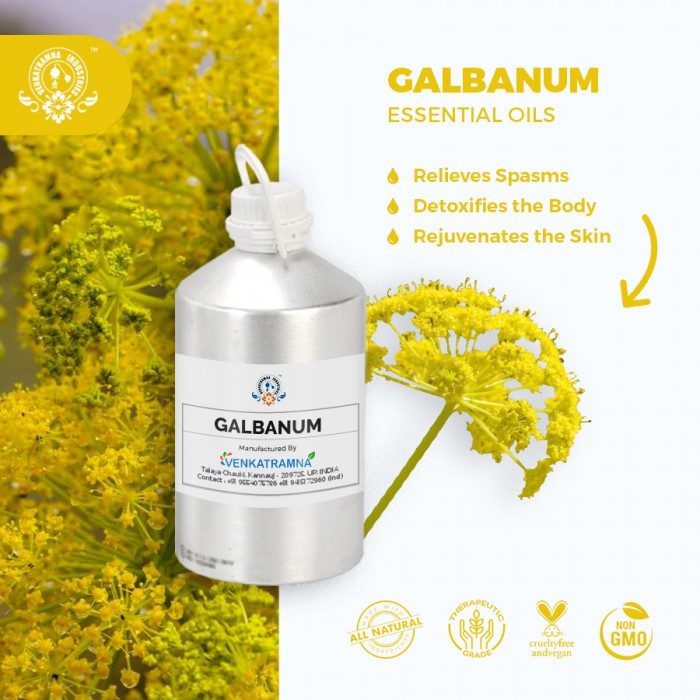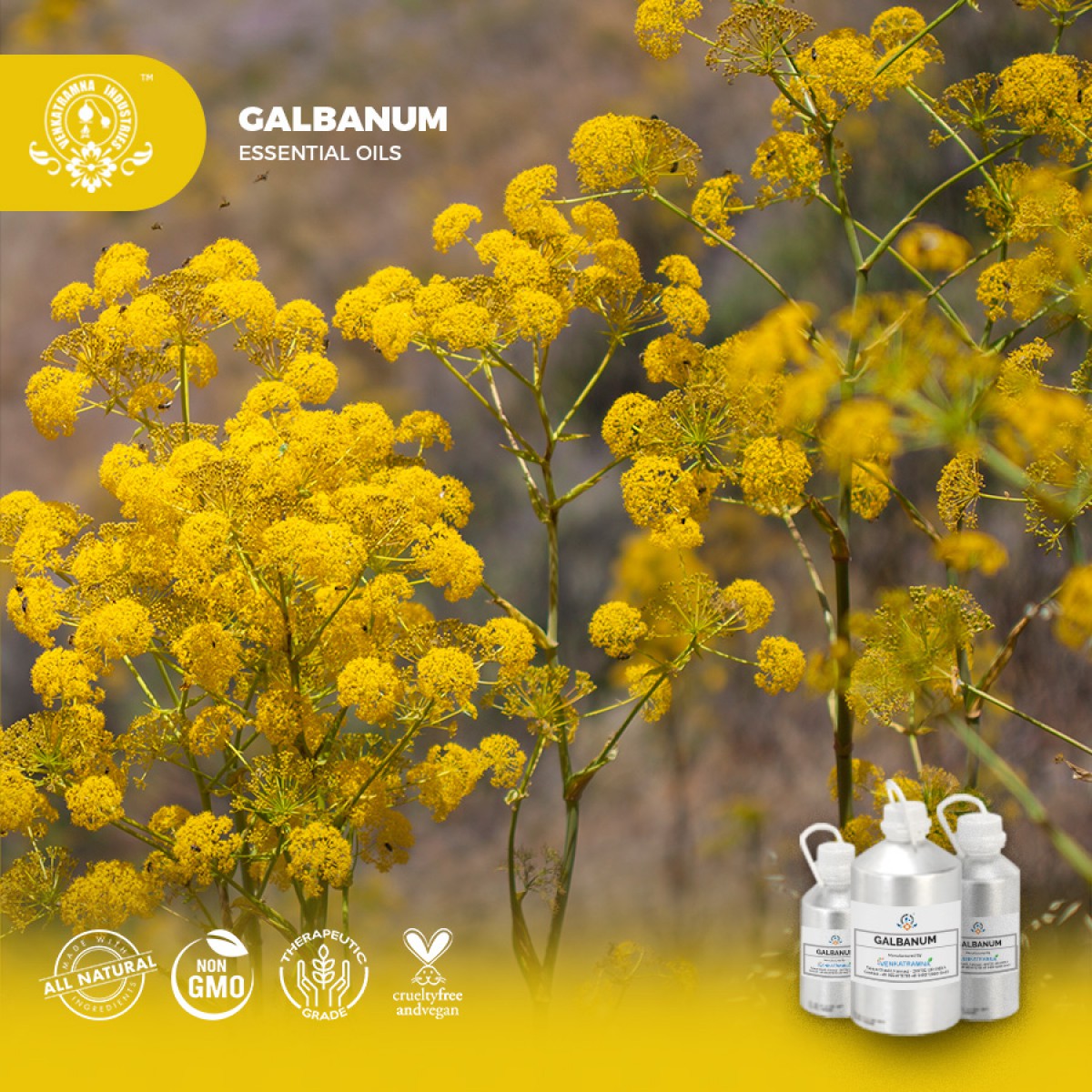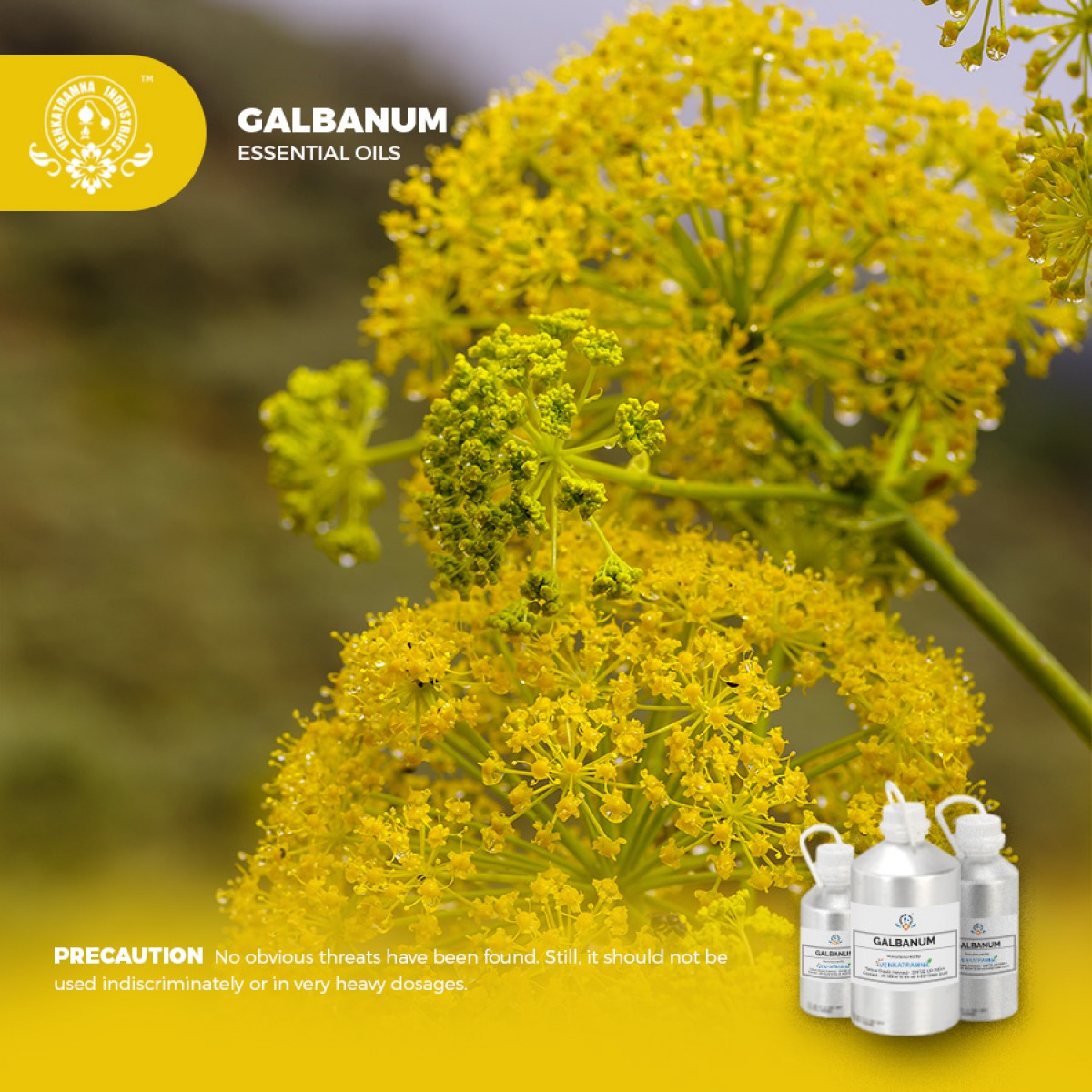Botanical Name: Ferula galbaniflua Common name: Galbanum Plant family Read More
|
Botanical Name: |
Ferula galbaniflua |
|
Common name: |
Galbanum |
|
Plant family: |
Apiaceae |
|
Genus: |
Ferula |
|
Appearance/Color: |
Colorless to pale olive yellow liquid, A viscous. |
|
Odor: |
A top note with a
medium aroma, Galbanum Essential Oil possesses an intensely fresh, green
leafy odor with a dry, bark-like back note. |
|
Blends With: |
Carrot Seed, Geranium, Lavender, Spruce and Rose Otto. |
|
Origin: |
France |
|
Source: |
Resin |
|
Method of
Extraction: |
Solvent Extraction |
Galbanum, a perennial herb with a
smooth, hollow stem and small white flowers, is native to the Middle East and
Western Asia. It is currently cultivated
in Iran, Turkey, Afghanistan, and Lebanon. The whole plant contains a milky
sap, but the gum resin known as the galbanum of commerce comes from the base of
the plant and the root. It is obtained by making incisions first in the base of
the plant to let the resin exude then in the root. Through steam distillation,
the resin of galbanum can produce a volatile oil which is colorless to pale
yellow or olive with an earthy, woody aroma.
Galbanum, sometimes confused with similar resins, has been known and used since ancient times. Galbanum is mentioned in the Bible (Exodus 30.34-35), not as a medicinal drug, but as an ingredient of a sacred incense (also including frankincense, onycha, etc.) destined to be burned in the “Tabernacle of the Congregation.” Pliny and Dioscorides refer to ancient Syria as the habitat of the galbanum plant. Galbanum was widely used in ancient Mesopotamia for medicinal purposes.
DISCLAIMER
The complete range of conditions
or methods of use are beyond our control therefore we do not assume any
responsibility and expressly disclaim any liability for any use of this
product. Information contained herein is believed to be true and accurate however,
all statements or suggestions are made without warranty, expressed or implied,
regarding accuracy of the information, the hazards connected with the use of
the material or the results to be obtained from the use thereof. Compliance
with all applicable federal, state, and local laws and local regulations
remains the responsibility of the user.
The FDA has not evaluated the
statements on this website. No claims are made by Venkatramna Industries as to
the medicinal value of any products from vriaroma.com or by us. The information
presented here is for educating our customers about the traditional uses of
essential oils and is not intended to diagnose, treat, cure, or prevent any
disease. You are responsible for understanding the safe application of these products.
If you have any questions, please call or email us for further information.
As per NAHA guidelines, New Directions Aromatics
(NDA) does not recommend the ingestion of essential oils. It is imperative to
consult a medical practitioner before using Essential Oils for therapeutic
purposes. Pregnant and nursing women and those taking prescription drugs are
especially advised not to use this product without the medical advice of a
physician. The oil should always be stored in an area that is inaccessible to
children, especially those under the age of 7.
Galbanum is rarely used in
pharmaceuticals today, but is still used as an aromatic agent in the production
of food and cosmetics, and is a particularly useful fixative in
soaps, detergents, lotions, and perfumes. In food products, galbanum and galbanum
oil are used in beverages, frozen dairy products, candy, baked goods, gelatins,
pudding, condiments, relishes, meat products, snack foods, and gravies.
Galbanum Oil in Pharma
Galbanum is a plant. A gum-like material (resin) is obtained
from the stems. The resin and roots are used to make medicine. People take
galbanum for diarrhea, gas (flatulence), poor appetite, cough, and seizure
disorder (epilepsy). Galbanum is sometimes applied directly to the skin to help
wounds heal.
Essence of Galbanum Oil
In food and beverages, galbanum oil and resin are used as
flavoring. In manufacturing, galbanum oil and resin are used as fragrance in
cosmetics.
COMMON USAGE
·
Cough.
·
Diarrhea.
·
Gas (flatulence).
·
Seizure disorder (epilepsy).
·
Wound healing.
Ingredients:
|
S.No |
Key Constituents |
Strength (%) |
|
1 |
b-pinene |
45.1-58.8 |
|
2 |
d-3-carene |
2.0-12.1 |
|
3 |
a-pinene |
5.7-12.0 |
|
4 |
Sabinene |
0-6.4 |
|
5 |
b-myrcene |
0-4.6 |
|
6 |
(P)-limonene |
2.7-4.0 |
|
7 |
g-elemene |
0-2.4 |
|
8 |
1,3,5-undecatriene |
1.6-1.8 |
|
9 |
(Z)-b-ocimene |
0-1.2 |
TOXICOLOGICAL
INFORMATION
Safety Summary
·
Hazards: Skin sensitization if oxidized.
·
Cautions: Old or oxidized oils should be
avoided.
Systemic Effects
·
Acute toxicity: Galbanum oil acute oral
LD50 in rats >5 g/kg; acute dermal LD50 in rabbits >5 g/kg.
o
Assumed Toxicity Value (LD50 or ATE) for Acute
Oral Toxicity: >5000
o
Assumed Toxicity Value (LD50 or ATE) for Acute
Dermal Toxicity: >5000
o
Assumed Toxicity Value (LC50 or ATE) for
o
Acute Inhalation Toxicity: Not Available
o
Inhalation Route: Not Available
·
Carcinogenic Potenitial: Not listed as
Carcinogen
·
Skin corrosion/irritation: May be irritating to
skin.
·
Serious eye damage/irritation: May be irritating
to eyes. Prompt rinsing and removal of the substance will avoid damage.
·
Respiratory sensitization: Not applicable under
normal use.
·
Germ cell mutagenicity: Not specified
·
Carcinogenicity: Not Listed As Carcinogen
·
Reproductive toxicity: Not specified
·
STOT-single exposure: Not specified
·
STOT-related exposure: Not specified
·
Aspiration hazard: Not specified
·
Interactive effects Not specified
ECOLOGICAL
INFORMATION
·
Toxicity : Toxic to aquatic life with
long lasting effects.
·
Persistence and degradability: No
Additional Data available.
·
Bio-accumulative potential: No Additional
Data available.
·
Mobility in soil: No Additional Data
available.
Do not allow the material to
enter streams, sewers or other waterways. Dispose of in accordance with local
regulations. Avoid disposing into drainage systems and into the environment.
Empty containers should be taken to an approved waste handling site for
recycling or disposal.





 MSDS-Galbanum.pdf
MSDS-Galbanum.pdf




